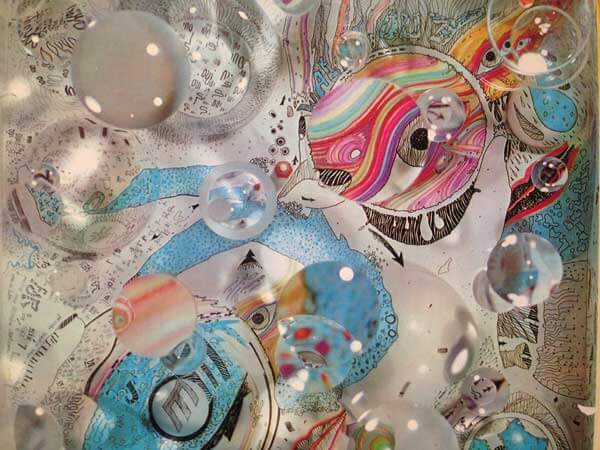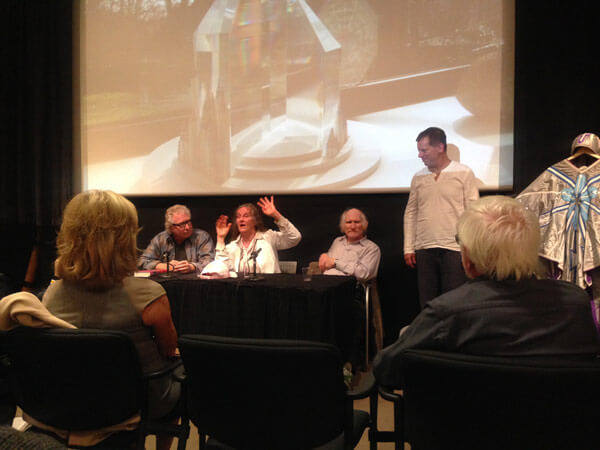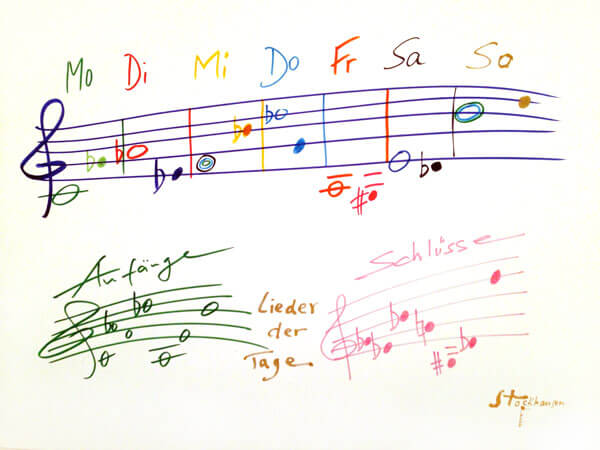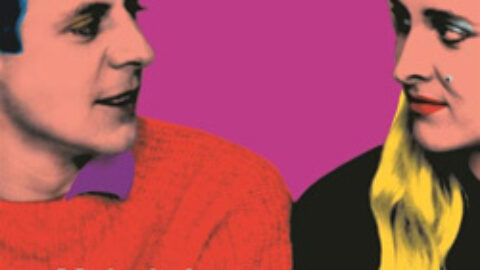 Chances are (for the uninitiated) that you may already know who Mary Bauermeister is without realizing it. Her visual style is intimately intertwined with the output of composer Karlheinz Stockhausen. Her beautifully sparse, colorful arrangements of text, musical symbols, and geometry not only grace the recent complete set of his oeuvre issued by Stockhausen Verlag but were also pivotal in informing his compositional style and attitudes (i.e. she convinced him to abandon his total-serialism). Turning 80 this year, Bauermeister’s journey comes alive in a newly published book, Ich hänge im Triolengitter: Mein Leben mit Karlheinz Stockhausen. On January 26, 2014 the Goethe-Institut in Los Angeles presented an afternoon tribute to Bauermeister. Loquacious and eloquent, she defied her octogenarianism with free-spirited charm and youthful idealism.
Chances are (for the uninitiated) that you may already know who Mary Bauermeister is without realizing it. Her visual style is intimately intertwined with the output of composer Karlheinz Stockhausen. Her beautifully sparse, colorful arrangements of text, musical symbols, and geometry not only grace the recent complete set of his oeuvre issued by Stockhausen Verlag but were also pivotal in informing his compositional style and attitudes (i.e. she convinced him to abandon his total-serialism). Turning 80 this year, Bauermeister’s journey comes alive in a newly published book, Ich hänge im Triolengitter: Mein Leben mit Karlheinz Stockhausen. On January 26, 2014 the Goethe-Institut in Los Angeles presented an afternoon tribute to Bauermeister. Loquacious and eloquent, she defied her octogenarianism with free-spirited charm and youthful idealism.
The event, envisioned as a conclusion to the previous night’s Jacaranda concert performance of Stockhausen’s Stimmung, opened with Gregor Zootzky’s intoxicating, short animated film ‘psst-pp-Piano : Hommage à Mary Bauermeister’. Establishing the context of her life and work, it is a re-telling of a notorious proto-fluxus action which Kay Larson describes in her 2012 biography of John Cage ‘Where the Heart Beats.’ Taking place in 1960 at Bauermeister’s atelier in Köln, it shows a distressing performance given by Nam June Paik in which he provokes Cage by cutting off his necktie with a pair of scissors, smashing windows, and running out of the room, leaving the audience “paralyzed with fear,” in Cage’s words. The performance is said to have ended once he telephoned Bauermeister, indicating that the performance had ended. Thus in her mid-twenties she was already confidently promoting the most experimental artists of the century, and close with not only Cage, but also David Tudor, George Brecht, Cornelius Cardew, as well as Stockhausen, whose composition class she had enrolled in at Darmstadt. Becoming enamored with one another, they decided on a radical move to the United States.

Bauermeister extrapolated the events of her life with vivid detail starting with her first night in NY, where she stayed at a $5/night lodge, sick from a days-long-delay on an Icelandic airline, and awaking to screams in the night (which, on November 22, 1963 would have been the eve of John F. Kennedy’s assassination). She described the events surrounding the premiere of Stockhausen’s Originale at the New York Avant-Garde Festival at Judson Hall (September 8, 1964), in which Fluxus artists denounced Stockhausen with picketed demonstrations. Their slogans, “THE PATRICIAN — THEORIST — OF WHITE SUPREMACY” and “FIGHT THE DOMINATION OF EUROPEAN RULING CLASS ART” brought into focus a point of contention surrounding her affiliation with Fluxus as imagined by George Maciunas, who was in fact the mastermind behind these demonstrations. Bauermeister revealed that it was Maciunas who was fascistic in his tendencies, speaking of his telephonic aural-assaults on complete strangers (amplified sound as sonic warfare) which essentially caused an irreparable schism in the Fluxus movement. She also insinuated that perhaps Maciunas was bitter, always one step behind her and her circle (missing Cage’s New School composition seminar due to Cage’s departure to Darmstadt and again missing the opportunity to perform at Bauermeister’s gallery in Köln due to her migration to NY). Bauermeister’s perspective places an interesting refraction on the controversy, suggesting that Stockhausen may have simply been used by Maciunas to avoid more overtly political grandstanding, thus enabling him to disguise his motives.

In her book (currently only available in German), whose title in English roughly means “Three in the Space of Two” (as in a compound 3 against 2 rhythm), she details the complicated and multifaceted polygamist tendencies that were a feature of Stockhausen’s personal life. She references not one but several ménage à trois which she was involved in during the course of their love. Bauermeister offered an interesting hypothesis regarding Stockhausen’s early childhood traumas and why it led him into seeking multiple relationships. Moreover, she described her own intermittent feelings of jealousy counterpoised by her unforgiving love for him. Rich and complex was this affair!
Bauermeister’s transcendent presence and attitude were mirrors into an era in which art embraced a variety of anarchic impulses to counter hostile and mechanical trends that were enclosing it. And yet her endearing composure belied the recalcitrant and merciless aesthetics of her art and the artworks of her contemporaries. Looking in, we were able to glimpse a fascinating view of the 20th century avant-garde as it happened. She represents a modern-day futurist, a time-traveler who beheld vistas deep into our own future and carried them with her throughout her life, all the while expressing them in her work. Such is her sensibility as it is communicated by the thrust of the boundary-defying art she is implicated in and responsible for creating. A striking visual genius coupled with an intricate and industrious attention to detail pervades her graphic work; universes unto themselves, dense with meaning, directionality, cosmic messages, and magically ambiguous.

One piece of interest on display was a letter she wrote to Barack Obama during his first month as president, in which she described ‘morphogenic fields of protection’ and optimism in his presidency. Purportedly, it found its way into the hands of Michelle Obama, who has made the effort to contact various art institutions and universities, indicating that we may see a resurgence of interest in the incredible work she has produced. When Bauermeister described her first experience of anarchy, it struck me as significant: as a young girl, occupying American soldiers allowed her back into her former home, where she was delighted and thrilled to find all of the polished furniture scuffed-up and horribly scratched, with all of the oil-painted heads hanging on the walls riddled with bullet-holes. Such memories, it would seem, indeed set the trajectory of her electrifying life.


